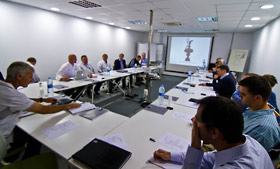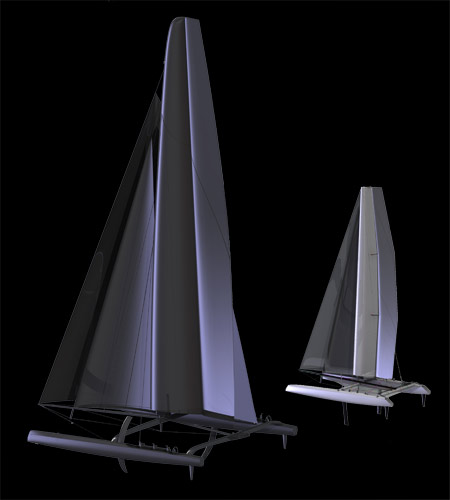|
December 12, 2010 |
||||||||||||||
|
|
||||||||||||||
With an objective of elevating the America's Cup as a sporting and spectator event, Larry Ellison and Russell Coutts turned to Morelli & Melvin Design & Engineering, Inc. to help figure out how to reach that goal. A consultant on the unprecedented wing sail for Cup-winner USA-17, Melvin took on the multihull portion of the studies used to evaluate potential new 2013 America’s Cup yachts. After looking at all the options within each of Morelli & Melvin's alternative designs, along with the monohull options, America’s Cup organizers opted for the big multihulls -- a decision that, good or bad, will indeed change the game. “We got a call in June asking us to start developing a rule for a multihull,” Melvin explained. “We’re the leaders of the group, but we had consultants from all over the world. BMWOR didn’t want just one person creating this rule; they wanted world-class input from everybody. We spent four months creating this rule and a lot of things changed along the way. For example, in a meeting back in May, when we were working in the initial study, we focused on a trimaran, as they are more forgiving and easy to sail and more high performance for the dollar. But there was a desire to have the boats easily shippable via air, and catamarans are more easily disassembled to go on a plane. Also, they wanted a wing instead of soft sails.
“So we spent more time on the technical side, sizing the boat, how big the rig should be. The desire was to be able to sail a race from three to 33 knots (wiggled down to five to 30) so we came up with a wing sail catamaran, with soft sails for downwind sailing. Carrying 11 crew members, it will do about three times true wind speed. “The rule is a box rule -- maximum length of 22 meters, 14 meters wide, and some sail area max areas, with minimum and maximum weight limits and it has to be a catamaran -- but everything else is pretty much open. You can have any hull shape you want. You’re allowed to have two rudders and two foils, but they can be curved or canting. The soft sails, for downwind sailing primarily, can be made of anything but they have to be foldable. There’s a height-and-area maximum for the wing, but aside from those restrictions, anything goes. And no computers on this boat -- the wing will be controlled manually, by hydraulics or cables or whatever mechanical means the designers come up with.” A major concern voiced by participants and media alike has been budgets -- and depending on who you believe, the budgets for the next America’s Cup could be anywhere from $20 to $100 million dollars. Numbers aside, Melvin broke down where he thinks the bulk of the budget will go and from which direction the biggest design breakthroughs might come. “The wing is a huge performance element and that’s where I think a lot of the gains will be made. Hulls are fairly well understood -- with a monohull, where the hull is very, very critical and a very key part of your design, you’ll spend a lot of your resources developing the hull shape. Multihulls are all long and skinny things and whether you make one with a little more “vee” or a little less rocker, it’s not going to change the drag characteristic of the hull that much. So a lot of those resources that you might have put into design engineering will go into the wing or the foils and less on the hulls.” Speaking of foils, it’s time for some new words in the vocabulary. We’ll start with the curved foils. Melvin explains: “They’re called dagger boards, but some people call them dagger foils. They not only prevent the boat from going sideways, they also lift the boat. I’m sure on some of the boats, they’ll cant them, so you can angle them under the boat and increase or decrease the amount of lift you can get. The faster the boat goes, the more you’ll want to lift it up on the foil and the more efficient it will be.” The initial plans had been for a one-design boat, but the more Melvin looked at it, the more loopholes he could see. The theory is that leaving the design open creates exciting possibilities for development. And we’re talking crazy speeds here; Melvin believes the design is open enough that someone might come up with a design that will near 40 knots of boat speed. But even with the baseline expectation of 30 knots boat speed, that’s two cats entering a starting box with a combined closing rate of 60 knots. As you would expect, safety is of the highest concern, prompting hinted-at modifications of the match racing rules to address the speed versus safety issue. “Sailing is risky, especially sailing at high speed, so we don’t know exactly what will happen,” said Melvin. “Safety is a consideration with the design of the boat, like limiting the number of sharp things people can fall into and making sure the trampolines are in appropriate places. But at the end of the day, it has to be a racing boat.” --Diane Swintal for CupInfo/©2010 CupInfo
|
||||||||||||||
Links of Interest: 10:30 pm PT Dec 12 2010 |

